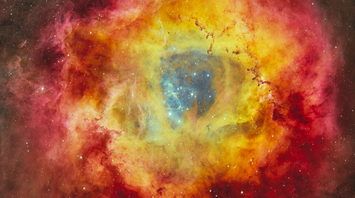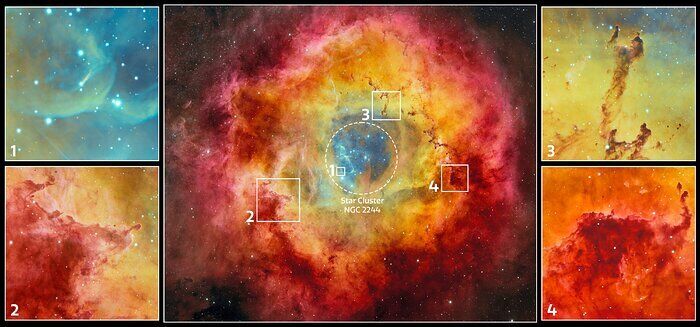NOIRLab Marks 5th Anniversary with a Mesmerizing Image of the Rosette Nebula

In celebration of its fifth anniversary, NOIRLab has published an extraordinary image of the Rosette Nebula, captured by the Dark Energy Camera (DECam) on NSF’s Víctor M. Blanco 4-meter Telescope at Cerro Tololo Inter-American Observatory in Chile, Sci News reported. Situated approximately 5,000 light-years from Earth in the constellation Monoceros, this stellar nursery also houses a young star cluster at its heart.
The Rosette Nebula, also known as Caldwell 49 or NGC 2239, extends across 1.3 degrees of the sky, which is roughly the width of an index finger held at arm’s length. Although spanning a diameter of 130 light-years – five times bigger than the Orion Nebula – it appears similarly sized due to being four times more distant.
"The absence of gas at its center is a prominent feature," stated NOIRLab astronomers, attributing it to the cluster’s massive stars, NGC 2244, formed around 2 million years ago. These stars, emerging from coalesced nebula gases, created stellar winds powerful enough to carve a central hollow. Ultraviolet radiation from these stars ionizes surrounding hydrogen, illuminating the nebula with an array of colors.

The DECam, unlike infrared-based tools such as the James Webb Space Telescope, captures images in optical wavelength similar to human vision, rendering the nebula in striking vivid hues. The glowing red clouds indicate regions of H-alpha emission caused by hydrogen atoms emitting red light, while the cavity walls display gold and yellow due to ionized oxygen. Edges of the "petals" feature deep pink tendrils from ionized silicon.
Encircling the nebula’s hollow core are dark clouds dubbed "elephant trunks" containing dust that obscures light. These structures border between ionized hydrogen and cooler gas and feature unique, trunk-like shapes resembling fingers pointing to NGC 2244. A key example of these features is the "Wrench Trunk," noted for its claw-like head and spiral "handle" shaped by the nebula’s magnetic field.
Less prominent but equally intriguing are the "dark globulettes," smaller than known globules, concentrated near the Wrench Trunk. Despite their small size, they might harbor brown dwarfs or planets within them.
In roughly 10 million years, the light and stellar winds from NGC 2244 will scatter the remaining dust and gas, causing the nebula to fade away and leaving the massive stars isolated without their gaseous and dusty birth cloud.
Earlier, SSP wrote about species can give birth to a record number of babies in one go.



















